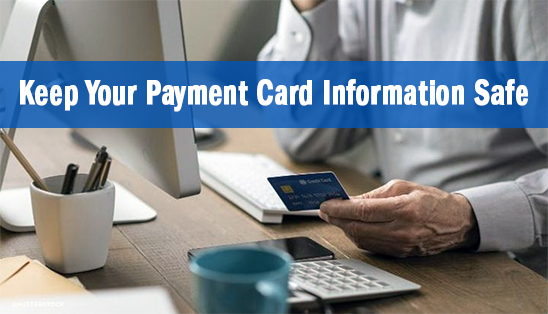Keep Your Payment Card Information Safe
March 1, 2021 •Admin

While it's said "Cash is King," that's certainly not true when it comes to retail purchases. In a 2019 study, the Federal Reserve Bank of San Francisco found consumers used cash only only 26% of transactions, down from 30% in 2017. Debit cards were the most used, making up 28% of payments and credit cards accounted for 23%.
While using a payment card - like a debit or credit card - is certainly convenient, there are risks associated with them. Unlike cash, there are more alternatives to receiving a refund for unauthorized credit or debit transactions, but it can be a hassle; and if your private information is stolen you face a lifetime of making sure it isn't used fraudulently.
Overall, it's much easier to protect your card information from theft in the first place. Here are a few tips to help you get started.
●Sign up for paperless statements. Electronic statements help with security because you don't have to worry about mail with your personal information getting lost or stolen.
●Create strong passwords. Make sure to use complex, unique passwords for each of your accounts, and take advantage of multi-factor authentication whenever it's an option. Select PIN numbers that aren't easy to guess, and don't use personal identifiers like your date of birth or phone number.
●Lock your card and use account alerts. Use debit/credit card controls to turn your card off in the case it's lost or stolen. You can also use these controls - or set up alerts in mobile or online banking - so you receive text or email account alerts, or even text messages, if certain criteria is met. (For example, you receive a text message any time a purchase of $250 or more is made with your debit card.)
●Review your statements. Something as easy as looking at the transactions on your monthly statement can help you identify questionable transactions.
●Monitor your accounts. Along those same lines, logging into your mobile app to review recent transactions can help you identify fraudulent activity much faster than waiting for your monthly statement.
●Shop securely online. Use sites you trust and recognize, and be sure the website address (URL) starts with "https://" If your browser features an autofill option, consider turning it off and avoid storing your payment card number at online shopping sites. Don't use public Wi-Fi for shopping - be sure your internet connection is secure or use a cellular connection.
●Shop securely in person. Add your payment cards to a mobile or digital wallet (i.e. Apple, Google, or Samsung Pay) to encrypt your transactions using your mobile device - the vendor doesn't even receive your card number.
While there are additional steps you can take to protect your accounts, this is a good start, and most of them will even make life a little easier. If you have specific questions about keeping your payment card information safe, contact your bank or card issuer.
The views, information, or opinions expressed in this article are solely those of the author and do not necessarily represent the views of Citizens State Bank and its affiliates, and Citizens State Bank is not responsible for and does not verify the accuracy of any information contained in this article or items hyperlinked within. This is for informational purposes and is no way intended to provide legal advice.
